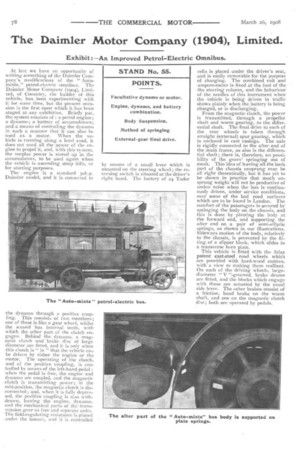The Daimler Motor Company (1904), Limited.
Page 24

If you've noticed an error in this article please click here to report it so we can fix it.
Exhibit : --An Improved Petrol-Electric Omnibus.
At last we have an opportunity of writing something of the Daimler Company's modifications of the " Automixte," petrol-electric omnibus. The Daimler Motor Company (roo4), Limited, of Coventry, the builder of this vehicle, has been experimenting with it for some time, but the present occasion is the lirst upon which it has been staged at any exhibition. Briefly put, the system consists of : a petrol engine; a dynamo; a battery of accumulators; and a means of controlling the dynamo in such a manner that it can also be used as a motor. When the vehicle is running along a level road, it does not need all the power of the engine to propel it, and, with this system, the surplus power is stored up in the accumulators, to be used again when the vehicle is ascending steep hills, or for starting purposes.
The engine is a standard 3oh.p. Daimler model, and it is connected to
the dynamo through a positive coupling. This consists of two members ; one of these is like a gear wheel, whilst the second has internal teeth, with which the .other part of the clutch engages. Behind the dynamo, a maga-wile clutch 'and brake disc of large diameter are fitted, and it is only when this clutch is " in "that the vehicle can be driven by either the engine or the motor: The operating of the clutch, and of the positive coupling, is controlled by means of the left-hand pedal : when the pedal is free, the engine and dynamo are coupled, and the magnetic -clutch is transmitting power; in the mid-position, the magnetic clutch is disconnected; and, when it is fully depressed, the positive coupling is also withdrawn, leaving the engine, dynamo, and the mechanical parts of the transmission gear as free and separate units. The field-regulating resistance is placed ••under the bonnet, and it is controlled
by means of a small lever which is mounted on the steering wheel; the reversing switch is situated at the driver's right hand. The battery of 24 Tudor cells is placed under the driver's seat, and is easily removable for the purpose of charging. The combined volt and ampere-meter is fixed at the foot of the the steering column, and the behaviour of the needles of this instrument when the vehicle is being driven in traffic shows plainly when the battery is being charged, or is discharging. From the magnetic clutch, the power is transmitted, through a propeller shaft and worm gearing, to the differential shaft. The final drive to each of the rear wheels is taken through straight (external) spur gearing, which is enclosed in cast casings. The axle is rigidly connected to the after end of the main frame, as also is the differential shaft ; there is, therefore, no possibility of the gears' springing out of mesh. This idea of leaving all the back part of the chassis unsprung may be all right theoretically, but it has yet to be shown in practice that much unsprung weight will not be productive of undue noise when the bus is continuously driven, under service conditions, over some of the bad road surfaces which are to be found in London. The comfort of the passengers is secured by springing the body on the chassis, and this is done by pivoting the body at the forward end, and supporting the after end on a pair of semi-elliptic springs, as shown in our illustrations. Sideways motion of the body, relatively to the chassis, is prevented by the fitting of a slipper block, which slides in a transverse horn plate.
This vehicle is fitted with the Atlas patent cast-steel road wheels which are provided with hard-wood centres, with a view to making them resilient. On each of the driving wheels, largediameter "V "-grooved, brake drums are fitted, and the blocks which engage with these are actuated by the usual side lever. The other brakes consist of a friction, band brake on the worm shaft, and one on the magnetic clutch disc; both are operated by pedals.




































